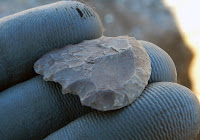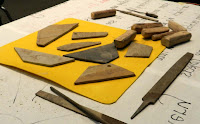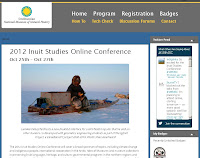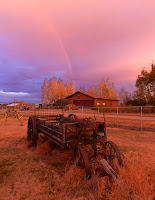 |
| The hardest part about this costume was finding a replacement hat for my dad to wear while I was out trick or treating. |
Wednesday, October 31, 2012
Happy Halloween
Monday, October 29, 2012
Pre-Dorset Endscraper with Serrated Base
 Here's an interesting little artifact that we found on a Pre-Dorset site in Nunavut this summer. Its an endscraper, with a smooth working edge and deeply serrated hafting area. A lot of the diagnostic tools from this particular site had serrated bases. It was my first time seeing this sort of treatment on bases, but I guess it does show up in the early Palaeoeskimo toolkits.
Here's an interesting little artifact that we found on a Pre-Dorset site in Nunavut this summer. Its an endscraper, with a smooth working edge and deeply serrated hafting area. A lot of the diagnostic tools from this particular site had serrated bases. It was my first time seeing this sort of treatment on bases, but I guess it does show up in the early Palaeoeskimo toolkits. |
| That's a 5cm scale. |
Photo Credit: Tim Rast
Friday, October 26, 2012
Lots of Travel, Demos and Workshops this Winter
 It looks like you will find me on the road rather than in the workshop this winter. Starting in January, I'll be conducting artifact replication workshops in Resolute Bay and Grise Fiord in Nunavut on behalf of Parks Canada. It looks like I'll be returning to Calgary a fourth time for the Flintknapping courses sponsored by the Archaeological Society of Alberta at the end of February/early March. If all goes well, I'll get out to some other centres in Alberta during that trip. Later in the winter, I'm hoping to get to Labrador to work with collections, colleagues, and students there. Watch this blog for updates.
It looks like you will find me on the road rather than in the workshop this winter. Starting in January, I'll be conducting artifact replication workshops in Resolute Bay and Grise Fiord in Nunavut on behalf of Parks Canada. It looks like I'll be returning to Calgary a fourth time for the Flintknapping courses sponsored by the Archaeological Society of Alberta at the end of February/early March. If all goes well, I'll get out to some other centres in Alberta during that trip. Later in the winter, I'm hoping to get to Labrador to work with collections, colleagues, and students there. Watch this blog for updates. |
| Yesterday I was working with grade fives participating in the Open Minds program at The Rooms. Always great energy. |
Wednesday, October 24, 2012
2012 Inuit Studies Online Conference
 From October 24-28 there is a large, international Inuit Studies Conference being held in Washington, D.C. If you're not able to attend in person, you can register to attend the conference online for free. There are 22 sessions being live streamed between October 25 and 27th - you can check out the complete program list at the Smithsonian's conference website here: http://inuit.smithsonianconference.org/sessions/
From October 24-28 there is a large, international Inuit Studies Conference being held in Washington, D.C. If you're not able to attend in person, you can register to attend the conference online for free. There are 22 sessions being live streamed between October 25 and 27th - you can check out the complete program list at the Smithsonian's conference website here: http://inuit.smithsonianconference.org/sessions/According to the conference website:
"The 2012 Inuit Studies Online Conference will cover a broad spectrum of topics, including climate change and indigenous people; international cooperation in the Arctic; roles of Museums and museum collections in preserving Inuit languages, heritage, and culture; governmental programs in the northern regions and their interactions with local communities and Inuit cultural/political institutions."
Photo Credit: Screen Grab from http://inuit.smithsonianconference.org/
Monday, October 22, 2012
Procrastinating
 |
| Tidying the shed |
Photo Credit: Lori White
Friday, October 19, 2012
Putting Tick Marks on Contour Lines
You know those little tick marks that you put on contour lines to show the direction of slope? Here's a confession, every year for the past 15 or 20 years, I've been adding those lines to maps individually, one at a time, with Photoshop or Adobe Illustrator I'd draw one tick mark and copy it a bunch of times and then rotate and place each one manually. Maps made at the end of the day or later in the week had fewer and fewer tick marks spaced wider and wider apart. But not anymore, here's a trick to make those tick marks perfectly consistent and much simpler. I'm using Adobe Illustrator in this example, but it should work in any vector graphics program that lets you make dashed lines. (click on the images to make them bigger)
 |
| Change the weight of the line. You can make it any weight you want - the thickness of the line will be the length of your tick marks. I made my 7 points. |
 |
| To create the individual tick marks, change the spacing of the gaps and dashes. I like using 1pt for the dashes and 20 pts for the gaps. |
 |
| That's it, its done. On a simple line this takes a few seconds. On a complex line, it might take a few minutes. |
Photo Credits: Screen Grabs from Adobe Illustrator
Wednesday, October 17, 2012
Red
 |
| Red Paint Chips |
 |
| Red Ochre |
Photo Credits: Tim Rast
Monday, October 15, 2012
Iqaluit Public Art
Friday, October 12, 2012
Wednesday, October 10, 2012
Mapping Again
 |
| Lines and labels from the paper map overlying the air photo. |
 |
| This layer has contour lines created from elevation data collected on site using a total station. |
Monday, October 8, 2012
CNEHA Display
 |
| Archaic Axe, Dorset Knife, Choris Pot |
 |
| Beothuk Pendant reproduction in the foreground and walrus bone pressure flaker in the back |
 |
| ground slate ulu with whalebone handle |
 |
| Choris pot |
 |
| Palaeoeskimo side-hafted microblade |
 |
| The pelts are harp seal on the left and ringed seal on the right |
Friday, October 5, 2012
New Business Cards
There's a conference in St. John's this weekend for the Council for Northeast Historic Archaeology. I'll be setting up a small display of reproductions in the bookroom and needed new cards with updated contact information.
Photo Credits: Tim Rast
Photo Credits: Tim Rast
Wednesday, October 3, 2012
Sunrise and new plans
 I'm back home and back at work in St. John's. I'm mostly scanning and digitizing site maps from the summer. Hopefully I'll get back into the workshop soon and have some new artifact reproductions to show. Its time to settle into a new fall routine and get some work done around the house. We're going to try to get the back deck built and maybe a few other home improvements done before the winter.
I'm back home and back at work in St. John's. I'm mostly scanning and digitizing site maps from the summer. Hopefully I'll get back into the workshop soon and have some new artifact reproductions to show. Its time to settle into a new fall routine and get some work done around the house. We're going to try to get the back deck built and maybe a few other home improvements done before the winter.
Before moving on to new things, here are a couple last photos from Alberta. Our last morning on the farm had a magnificent sunrise and light showers with a perfect rainbow over the yard. Hard to leave those big Alberta skies.
 |
| Can you identify this piece of farm equipment? The top photo has a different view. |






















